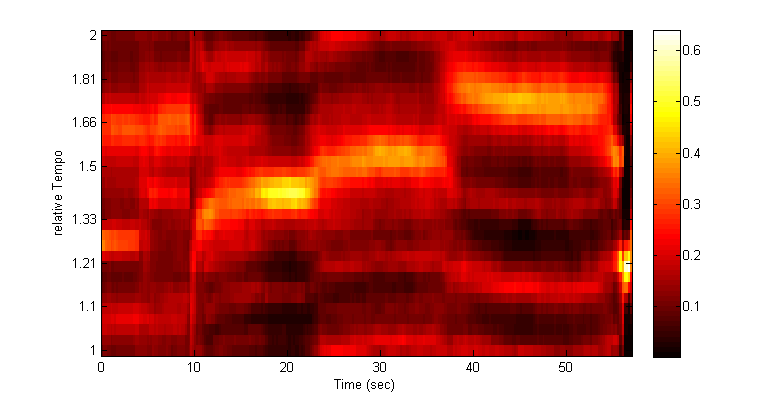Contents
%%%%%%%%%%%%%%%%%%%%%%%%%%%%%%%%%%%%%%%%%%%%%%%%%%%%%%%%%%%%%%%%%%%%%%%%%%%%%%% % Name: test_compute_cyclicTempogram_autocorrelation.m % Date of Revision: 2011-10 % Programmer: Peter Grosche % http://www.mpi-inf.mpg.de/resources/MIR/tempogramtoolbox/ % % Description: Illustrates the following steps: % 1. loads a wav file % 2. computes a novelty curve % 3. computes a autocorrelation-based tempogram % 4. derives a cyclic tempogram % 5. visualizes the cyclic tempogram % % Audio recordings are obtained from: Saarland Music Data (SMD) % http://www.mpi-inf.mpg.de/resources/SMD/ % % License: % This file is part of 'Tempogram Toolbox'. % % 'Tempogram Toolbox' is free software: you can redistribute it and/or modify % it under the terms of the GNU General Public License as published by % the Free Software Foundation, either version 2 of the License, or % (at your option) any later version. % % 'Tempogram Toolbox' is distributed in the hope that it will be useful, % but WITHOUT ANY WARRANTY; without even the implied warranty of % MERCHANTABILITY or FITNESS FOR A PARTICULAR PURPOSE. See the % GNU General Public License for more details. % % You should have received a copy of the GNU General Public License % along with 'Tempogram Toolbox'. If not, see % <http://www.gnu.org/licenses/>. % % Reference: % Peter Grosche, Meinard Müller, and Frank Kurth % Cyclic Tempogram - A Mid-level Tempo Representation For Music Signals % Proceedings of IEEE International Conference on Acoustics, Speech, and Signal Processing (ICASSP), Dallas, Texas, USA, 2010. % %%%%%%%%%%%%%%%%%%%%%%%%%%%%%%%%%%%%%%%%%%%%%%%%%%%%%%%%%%%%%%%%%%%%%%%%%%% clear close all dirWav = 'data_wav/'; filename = 'Debussy_SonataViolinPianoGMinor-02_111_20080519-SMD-ss135-189.wav';
1., load wav file, automatically converted to Fs = 22050 and mono
%%%%%%%%%%%%%%%%%%%%%%%%%%%%%%%%%%%%%%%%%%%%%%%%%%%%%%%%%%%%%%%%%%%%%%%%%%% [audio,sideinfo] = wav_to_audio('',dirWav,filename); Fs = sideinfo.wav.fs;
2., compute novelty curve
%%%%%%%%%%%%%%%%%%%%%%%%%%%%%%%%%%%%%%%%%%%%%%%%%%%%%%%%%%%%%%%%%%%%%%%%%%%
parameterNovelty = [];
[noveltyCurve,featureRate] = audio_to_noveltyCurve(audio, Fs, parameterNovelty);
3., compute autocorrelation-based tempogram (log tempo axis)
%%%%%%%%%%%%%%%%%%%%%%%%%%%%%%%%%%%%%%%%%%%%%%%%%%%%%%%%%%%%%%%%%%%%%%%%%%% octave_divider = 30; %15, 30, 60 ,120 parameterTempogram = []; parameterTempogram.featureRate = featureRate; parameterTempogram.tempoWindow = 6; % window length in sec parameterTempogram.maxLag = 2; % corresponding to 30 bpm parameterTempogram.minLag = 0.1; % corresponding to 600 bpm [tempogram, T, timeLag] = noveltyCurve_to_tempogram_via_ACF(noveltyCurve,parameterTempogram);
4., derive cyclic tempogram
%%%%%%%%%%%%%%%%%%%%%%%%%%%%%%%%%%%%%%%%%%%%%%%%%%%%%%%%%%%%%%%%%%%%%%%%%%%
parameterCyclic = [];
parameterCyclic.octave_divider = octave_divider;
[cyclicTempogram] = tempogram_to_cyclicTempogram(tempogram, 60./timeLag, parameterCyclic);
cyclicTempogram = normalizeFeature(cyclicTempogram,2, 0.0001);
5, visualize
%%%%%%%%%%%%%%%%%%%%%%%%%%%%%%%%%%%%%%%%%%%%%%%%%%%%%%%%%%%%%%%%%%%%%%%%%%%
visualize_cyclicTempogram(cyclicTempogram,T)
